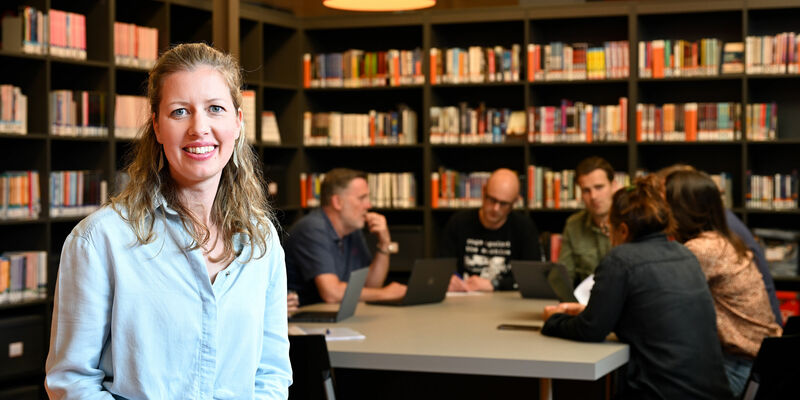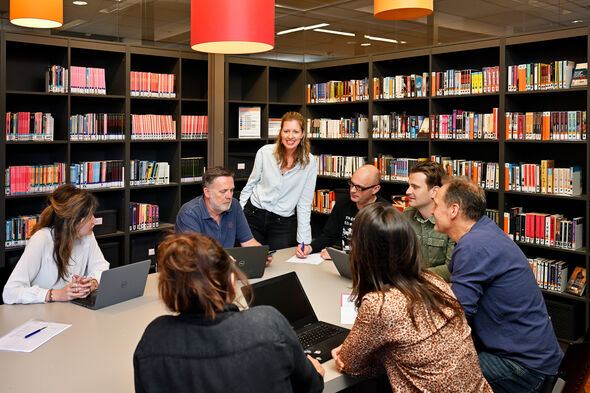
- Education , Research , Home Stretch
- 11/05/2023
Home Stretch | Making more objective decisions about students
At the end of each school year, high school teachers take a joint decision about students who don’t meet the requirements to move on to the next grade. Janneke Sleenhof, who defends her dissertation tomorrow, investigated how these allocation decisions come about and developed a program to improve the collective decision-making process. This should enable schools to make its decisions as objectively as possible.
Alongside her position at the Eindhoven School of Education (ESoE), Sleenhof has been working as a teacher of Dutch at Sint-Joriscollege high school in Eindhoven for over ten years now. This has given her a wealth of experience when it comes to the annual allocation meetings. It is during these meetings that teachers come together to discuss students that don’t meet the requirements to move on to next year nor show results that require them to retain without any doubt. “There are students with good grades who are sent through as a matter of course and students for whom retention is the only possible choice, but there’s a big grey area in between,” she says.
Doubt and insecurity
Sleenhof noticed that the annual allocation meetings gave her feelings of doubt and insecurity. Because how do you collectively make sure that you have as complete a picture of every student as possible? How do you weigh up different arguments? And how do you collectively reach a well-considered decision, in as objectively a way as possible? All of that’s quite challenging, the teacher found herself thinking. “Afterwards I often wondered: Did we do the right thing?”
When she talked about it to her colleagues, she found out they were struggling with the same doubts. “When I asked someone: ‘Why do we do it this way?’, nobody could give me an answer,” she says. “Everyone wants the best for the students, but we simply didn’t know exactly how to go about it.” Sleenhof started to study this collective decision-making process and decided to embark on a PhD themed around this subject.
Not entirely objective
The process of collective allocation decisions is a rarely mentioned subject that has never been investigated in this kind of depth. “It’s very complex, because different factors influence the decision-making process, such as the extent to which the teachers involved participate in the meeting and the role of the discussion leader,” Sleenhof explains.
Schools have little protocol on the way these decisions are made and how to run such a meeting. “Everyone’s doing their own thing,” she states. There are a number of tools, such as the Magister registration system, that may make the decision-making slightly easier, but that’s not enough according to Sleenhof. “A program like that works with plusses and minuses, so very fact-based, but in practice it’s never that black and white.”
That making the decision-making process entirely objective is impossible was clear to Sleenhof from the start. Nor was this ever her intention. Hence, the main goal of her PhD research was to see how you can collectively do a better job. “You’ll never be able to leave this up to a tool in which you enter data and that simply gives you a decision. But you can do it in a structured way, so the process is the same for all students and is therefore fairer and more objective.
Structure and interaction
During the first part of her research, Sleenhof interviewed teachers to take stock of what they think is going well and what could be improved. She then observed what happens during the meetings. To this end, she observed and analyzed allocation meetings at several high schools. In so doing, she mainly focused on the structure of the meetings and the interaction between teachers – the two factors that the interviews revealed to make the greatest impact on the decision-making process.
She clearly saw different types of structure and tried to categorize them. “They ranged from quite strict and clear to very chaotic. In the latter case, discussions went every which way and were very hard to follow,” she explains. The interactions also ranged significantly – from functional, constructive and open, to dysfunctional to the point where people were afraid to say anything. And there were also sizeable differences between and within schools when it came to structure and interaction.
Fair, transparent and acceptable
The next step in the research was defining what constitutes an objective decision. What is objectivity and what criteria apply? Inspired by qualitative research methodology, Sleenhof ended up with the three most important key objectivity criteria: a decision must be fair (so the same for all students), transparent (so supported by clear reasoning) and acceptable to everyone involved.
She went on to formulate concrete implications for practice based on these criteria. Key elements include a clear structure to the meeting, a well-reasoned proposal and careful consideration of all arguments. The implications have been supplemented with examples and fictional cases that allow teachers to practice. In other words, the research doesn’t only offer important insights, but also shows how you can apply all of them to practice. This makes it a practically applicable program that teachers can use to make the decision-making process more objective.
Implementation
The program has already been tested and evaluated by a number of teachers. “General response has been very positive,” Sleenhof says. “The teachers are happy to finally have a step-by-step plan.” Starting the coming school year, the PhD candidate will have the opportunity to roll out the program across the schools that fall under Ons Middelbaar Onderwijs (OMO), the association of high schools in the Dutch province of Noord-Brabant.
OMO has around sixty member schools, so it will take a few years to implement the program everywhere. “We’ll start with schools that are eager to participate and hope to create enthusiasm for the program with more and more schools.” You have to think carefully about the implementation, Sleenhof emphasizes. “It’s a very useful program, but it does have to be properly embedded in the existing structures and organizations. You can’t just copy-paste it; you first have to make sure it suits the school concerned.”
When asked if, in closing, she would like to give other teachers any advice, she says: “Talk to each other about it, because that doesn’t happen enough. Why do we do it this way? What’s important to us? That often gets snowed under in the hustle and bustle of daily life, but it’s such an important decision. And if you want to do something concrete, make sure that the meeting has a clear structure, that discussions are based on well-reasoned proposals and that at the end you check if you’ve covered all the bases. You’ll never be sure if you took the right decision, but you can at least make the whole process leading up to it, how you make the decision, as objective as possible.

Discussion